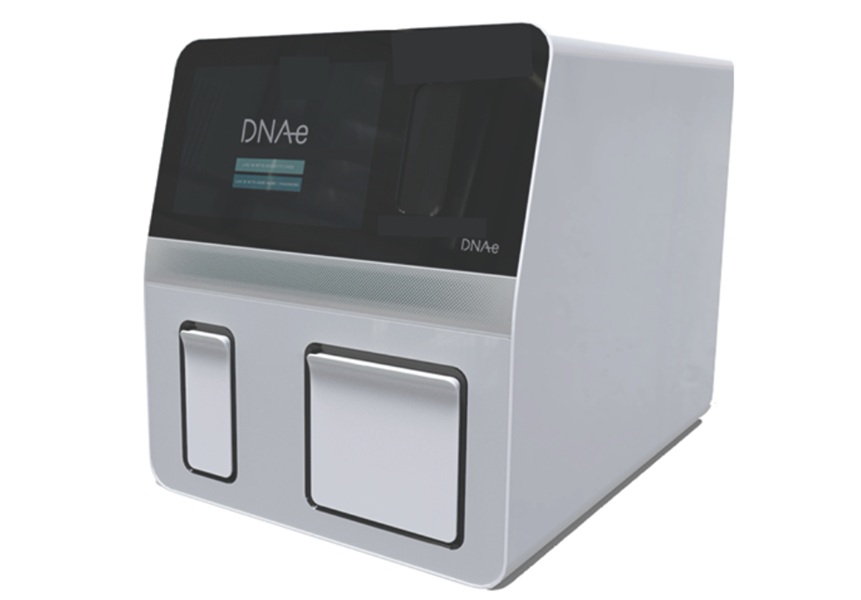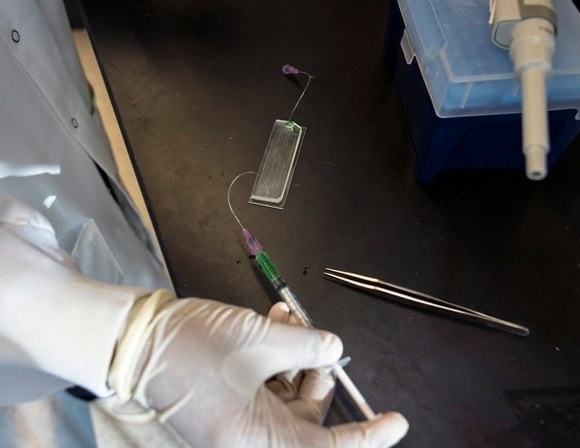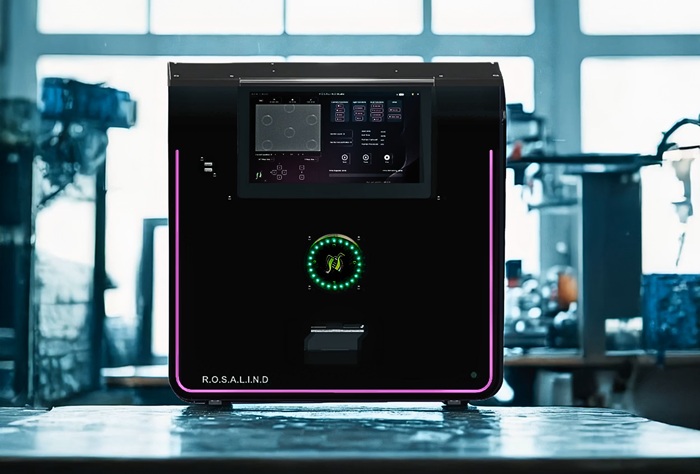New Diagnostic Test for Pancreatic Cancer Is Based on the Differential Expression of Select miRNAs in Plasma and Bile
|
By LabMedica International staff writers Posted on 10 Nov 2014 |
A panel of microRNA (miRNA) biomarkers was assembled from the pool of miRNAs present in the blood of most pancreatic cancer patients that may serve as a diagnostic tool and an indicator of the disease’s aggressiveness.
Pancreatic cancer is the fourth most common cause of cancer death in the Western world. The prognosis is poor, with one- and five-year survival rates of only 20% and 6%, respectively. Therefore, markers of the disease that could help with early diagnosis are needed to improve the prognosis. Statistics from the [US] National Cancer Institute (Bethesda, MD, USA) show that only about 6% of people with pancreatic cancer survive more than five years after diagnosis. In 2013 an estimated 45,220 new cases of pancreatic cancer were expected to be diagnosed with more than 38,460 of the cases being fatal.
MiRNAs are snippets of about 20 nucleotides that block gene expression by attaching to molecules of messenger RNA (mRNA) in a fashion that prevents them from transmitting the protein synthesizing instructions they had received from the DNA.
Investigators at Indiana University (Indianapolis, USA) determined miRNA levels in blood or bile obtained from 215 patients with pancreatic ductal adenocarcinoma (PDAC) or from controls. Panels were derived from the differential expression of 10 candidate miRNAs in the samples. MiRNAs that had excellent accuracy for inclusion in regression models were selected. Total RNA was isolated from samples using Trizol-LS (Life Technologies; Carlsbad, CA, USA). Complementary DNA was generated using 10 ng of RNA in conjunction with miRNA-10b, -21, -30c, -106b, -132, -155, -181a, -181b, -196a, -212, or -425-5p reverse transcription primers and a miRNA reverse transcription kit (Life Technologies). Quantitative PCR was performed for each miRNA using Taqman (Life Technologies) miRNA expression assay reagents.
Results revealed that increased expression of miRNA-10b, -155, and -106b in plasma appeared to be highly accurate for diagnosing pancreatic cancer.
Senior author Dr. Murray Korc, professor of cancer research at Indiana University, said, “This is a new finding that extends previous knowledge in this field. The key new feature here is that there is a panel of microRNAs that can be measured accurately in the plasma component of blood to determine if a patient has pancreatic cancer. It may be possible to use a blood test to screen individuals who are at high risk for developing pancreatic cancer. We are planning to conduct such studies. It will be important to identify additional markers and to assess how useful a panel of such markers would be for the early diagnosis of this cancer. Based on our findings, this test could also be useful to differentiate between pancreatic cancer and chronic pancreatitis.”
The study was published in the October 28, 2014, online edition of the American Journal of Gastroenterology.
Related Links:
National Cancer Institute
Indiana University
Life Technologies
Pancreatic cancer is the fourth most common cause of cancer death in the Western world. The prognosis is poor, with one- and five-year survival rates of only 20% and 6%, respectively. Therefore, markers of the disease that could help with early diagnosis are needed to improve the prognosis. Statistics from the [US] National Cancer Institute (Bethesda, MD, USA) show that only about 6% of people with pancreatic cancer survive more than five years after diagnosis. In 2013 an estimated 45,220 new cases of pancreatic cancer were expected to be diagnosed with more than 38,460 of the cases being fatal.
MiRNAs are snippets of about 20 nucleotides that block gene expression by attaching to molecules of messenger RNA (mRNA) in a fashion that prevents them from transmitting the protein synthesizing instructions they had received from the DNA.
Investigators at Indiana University (Indianapolis, USA) determined miRNA levels in blood or bile obtained from 215 patients with pancreatic ductal adenocarcinoma (PDAC) or from controls. Panels were derived from the differential expression of 10 candidate miRNAs in the samples. MiRNAs that had excellent accuracy for inclusion in regression models were selected. Total RNA was isolated from samples using Trizol-LS (Life Technologies; Carlsbad, CA, USA). Complementary DNA was generated using 10 ng of RNA in conjunction with miRNA-10b, -21, -30c, -106b, -132, -155, -181a, -181b, -196a, -212, or -425-5p reverse transcription primers and a miRNA reverse transcription kit (Life Technologies). Quantitative PCR was performed for each miRNA using Taqman (Life Technologies) miRNA expression assay reagents.
Results revealed that increased expression of miRNA-10b, -155, and -106b in plasma appeared to be highly accurate for diagnosing pancreatic cancer.
Senior author Dr. Murray Korc, professor of cancer research at Indiana University, said, “This is a new finding that extends previous knowledge in this field. The key new feature here is that there is a panel of microRNAs that can be measured accurately in the plasma component of blood to determine if a patient has pancreatic cancer. It may be possible to use a blood test to screen individuals who are at high risk for developing pancreatic cancer. We are planning to conduct such studies. It will be important to identify additional markers and to assess how useful a panel of such markers would be for the early diagnosis of this cancer. Based on our findings, this test could also be useful to differentiate between pancreatic cancer and chronic pancreatitis.”
The study was published in the October 28, 2014, online edition of the American Journal of Gastroenterology.
Related Links:
National Cancer Institute
Indiana University
Life Technologies
Latest Pathology News
- AI Tool Simultaneously Identifies Genetic Mutations and Disease Type
- Rapid Low-Cost Tests Can Prevent Child Deaths from Contaminated Medicinal Syrups
- Tumor Signals in Saliva and Blood Enable Non-Invasive Monitoring of Head and Neck Cancer
- Common Health Issues Can Influence New Blood Tests for Alzheimer’s Disease
- Blood Test Formula Identifies Chronic Liver Disease Patients with Higher Cancer Risk
- Tunable Cell-Sorting Device Holds Potential for Multiple Biomedical Applications
- AI Tool Outperforms Doctors in Spotting Blood Cell Abnormalities
- AI Tool Rapidly Analyzes Complex Cancer Images for Personalized Treatment
- Diagnostic Technology Performs Rapid Biofluid Analysis Using Single Droplet
- Novel Technology Tracks Hidden Cancer Cells Faster
- AI Tool Improves Breast Cancer Detection
- AI Tool Predicts Treatment Success in Rectal Cancer Patients
- Blood Test and Sputum Analysis Predict Acute COPD Exacerbation
- AI Tool to Transform Skin Cancer Detection with Near-Perfect Accuracy
- Unique Immune Signatures Distinguish Rare Autoimmune Condition from Multiple Sclerosis
- Simple Optical Microscopy Method Reveals Hidden Structures in Remarkable Detail
Channels
Clinical Chemistry
view channel
Noninvasive Blood-Glucose Monitoring to Replace Finger Pricks for Diabetics
People with diabetes often need to measure their blood glucose multiple times a day, most commonly through finger-prick blood tests or implanted sensors. These methods can be painful, inconvenient, and... Read more
POC Breath Diagnostic System to Detect Pneumonia-Causing Pathogens
Pseudomonas aeruginosa is a major cause of hospital-acquired and ventilator-associated pneumonia, particularly in lung transplant recipients and patients with structural lung disease. Its ability to form... Read moreMolecular Diagnostics
view channel
World's First NGS-Based Diagnostic Platform Fully Automates Sample-To-Result Process Within Single Device
Rapid point-of-need diagnostics are of critical need, especially in the areas of infectious disease and cancer testing and monitoring. Now, a direct-from-specimen platform that performs genomic analysis... Read more
Rapid Diagnostic Breakthrough Simultaneously Detects Resistance and Virulence in Klebsiella Pneumoniae
Antibiotic resistance is a steadily escalating threat to global healthcare, making common infections harder to treat and increasing the risk of severe complications. One of the most concerning pathogens... Read moreHematology
view channel
MRD Tests Could Predict Survival in Leukemia Patients
Acute myeloid leukemia is an aggressive blood cancer that disrupts normal blood cell production and often relapses even after intensive treatment. Clinicians currently lack early, reliable markers to predict... Read more
Platelet Activity Blood Test in Middle Age Could Identify Early Alzheimer’s Risk
Early detection of Alzheimer’s disease remains one of the biggest unmet needs in neurology, particularly because the biological changes underlying the disorder begin decades before memory symptoms appear.... Read more
Microvesicles Measurement Could Detect Vascular Injury in Sickle Cell Disease Patients
Assessing disease severity in sickle cell disease (SCD) remains challenging, especially when trying to predict hemolysis, vascular injury, and risk of complications such as vaso-occlusive crises.... Read more
ADLM’s New Coagulation Testing Guidance to Improve Care for Patients on Blood Thinners
Direct oral anticoagulants (DOACs) are one of the most common types of blood thinners. Patients take them to prevent a host of complications that could arise from blood clotting, including stroke, deep... Read moreImmunology
view channel
Blood Test Could Identify Colon Cancer Patients to Benefit from NSAIDs
Colon cancer remains a major cause of cancer-related illness, with many patients facing relapse even after surgery and chemotherapy. Up to 40% of people with stage III disease experience recurrence, highlighting... Read moreBlood Test Could Detect Adverse Immunotherapy Effects
Immune checkpoint inhibitors have transformed cancer treatment, but they can also trigger serious immune-related adverse events that damage healthy organs and may become life-threatening if not detected early.... Read moreMicrobiology
view channel
New UTI Diagnosis Method Delivers Antibiotic Resistance Results 24 Hours Earlier
Urinary tract infections affect around 152 million people every year, making them one of the most common bacterial infections worldwide. In routine medical practice, diagnosis often relies on rapid urine... Read more
Breakthroughs in Microbial Analysis to Enhance Disease Prediction
Microorganisms shape human health, ecosystems, and the planet’s climate, yet identifying them and understanding how they are related remains a major scientific challenge. Even with modern DNA sequencing,... Read moreTechnology
view channel
Diagnostic Chip Monitors Chemotherapy Effectiveness for Brain Cancer
Glioblastoma is one of the most aggressive and fatal brain cancers, with most patients surviving less than two years after diagnosis. Treatment is particularly challenging because the tumor infiltrates... Read more
Machine Learning Models Diagnose ALS Earlier Through Blood Biomarkers
Amyotrophic lateral sclerosis (ALS) is a rapidly progressive neurodegenerative disease that is notoriously difficult to diagnose in its early stages. Early symptoms often overlap with other neurological... Read moreIndustry
view channel
BD and Penn Institute Collaborate to Advance Immunotherapy through Flow Cytometry
BD (Becton, Dickinson and Company, Franklin Lakes, NJ, USA) has entered into a strategic collaboration with the Institute for Immunology and Immune Health (I3H, Philadelphia, PA, USA) at the University... Read more























